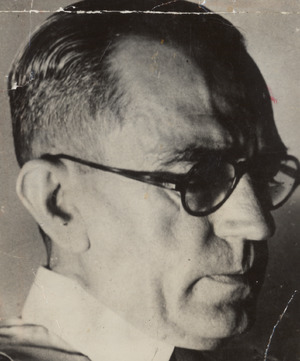Graciliano Ramos facts for kids
Quick facts for kids
Graciliano Ramos
|
|
|---|---|

Ramos in 1940
|
|
| Born |
Graciliano Ramos de Oliveira
October 27, 1892 |
| Died | March 20, 1953 (aged 60) Rio de Janeiro, Brazil
|
| Nationality | Brazilian |
| Other names | Feliciano de Olivença Almeida Cunha |
| Occupation | Novelist, politician, journalist |
|
Notable work
|
Vidas Secas, Angústia, São Bernardo, A Terra dos Meninos Pelados |
| Height | 1.75 m (5 ft 9 in) |
| Title | Mayor of Palmeira dos Índios |
| Term | 1928–1930 |
| Political party | Brazilian Communist Party |
| Spouse(s) | Maria Augusta de Barros (1915–1920) (her death) Heloísa Leite de Medeiros (1928–1953) (his death) |
| Children | Márcio Ramos (1916–1950) Júnio Ramos (1917–1975) Múcio Ramos (1919–1994) Maria Ramos (1920–1980) Ricardo Ramos (1929–1992) Roberto Ramos (1930) Luísa Ramos (1931–) Clara Ramos (1932–1993) |
| Parent(s) | Sebastião Ramos de Oliveira (died 1934) Maria Amélia Ramos (died 1943) |
Graciliano Ramos de Oliveira (born October 27, 1892 – died March 20, 1953) was a famous Brazilian writer. He was known for his unique style, often called modernist. Graciliano was also a politician and a journalist. Many of his books, especially Vidas Secas, tell stories about the tough lives of poor people in the Brazilian countryside, known as the sertão.
Contents
Graciliano Ramos: A Brazilian Writer
Early Life and First Steps
Graciliano Ramos de Oliveira was born in Quebrangulo, Alagoas, Brazil. This was on October 27, 1892. He was the oldest of 16 children. His parents were Sebastião Ramos de Oliveira and Maria Amélia Ramos.
Graciliano spent much of his childhood moving around different cities in Northeast Brazil. After finishing high school in Maceió, he started writing for the Jornal de Alagoas newspaper in 1909. He used different pen names, like Almeida Cunha and Feliciano de Olivença. He even started his own newspaper for a short time in 1906.
In 1914, Graciliano moved to Rio de Janeiro. But he returned to Alagoas in 1915 to live with his father. His father had become a salesman in Palmeira dos Índios. In 1915, Graciliano married his first wife, Maria Augusta de Barros. They had four children together. Maria Augusta passed away in 1920.
Becoming a Writer and Mayor
In 1927, Graciliano Ramos was chosen to be the mayor of Palmeira dos Índios. He started his job in 1928 and left it in 1930. People were very impressed by how well he wrote his reports as mayor. A famous writer, Augusto Frederico Schmidt, encouraged him to publish his first novel.
Graciliano had started writing his first novel, Caetés, around 1925. He finished it in 1930, but it was not published until 1933. In 1928, he married his second wife, Heloísa Leite de Medeiros. They had four more children.
Challenges and Famous Books
From 1930 to 1936, Graciliano lived in Maceió again. In 1934, he published his novel São Bernardo. The next year, he was arrested for political reasons. He wrote about his time in prison in a book called Memórias do Cárcere. This book was published after he passed away in 1953.
After being released from prison, he published his very famous novel, Angústia. He got help from friends like José Lins do Rego to publish it.
In 1938, he published Vidas Secas. This book is one of his most well-known works. After this, he moved to Rio de Janeiro for good. In 1945, he joined the Communist Party of Brazil. In the years that followed, he traveled with his wife to countries like France, Portugal, the Soviet Union, and Czechoslovakia. Also in 1945, he published a book about his childhood called Infância.
Later Years and Legacy
Starting in 1952, Graciliano's health began to get worse. He was diagnosed with a serious illness. After an operation that was not successful, he passed away on March 20, 1953. His wife, Heloísa, lived for 46 more years.
Graciliano Ramos is remembered through his daughter, grandchildren, and great-grandchildren. His books continue to be read and studied by many people.
Graciliano's Books
Graciliano Ramos wrote many different kinds of books.
Novels for Young Readers
- A Terra dos Meninos Pelados (The Naked Boys' Land) (1939) - This is a novel for children.
- Histórias de Alexandre (Alexandre's Stories) (1944) - A book of short stories.
- Alexandre e Outros Heróis (Alexandre and Other Heroes) (1962) - Published after he passed away.
Other Stories and Memoirs
- Caetés (1933)
- São Bernardo (1934)
- Angústia (Anguish) (1936)
- Vidas Secas (Barren Lives) (1938)
- Brandão Entre o Mar e o Amor (Brandão Between the Sea and Love) (1942) - He wrote this with other authors.
- Histórias Incompletas (Unfinished Stories) (1946) - A book of short stories.
- Insônia (Insomnia) (1947) - Another short story collection.
- Infância (1945) - A book about his childhood memories.
- Memórias do Cárcere (Memories from Incarceration) (1953) - Published after he passed away.
- Viagem (Travel) (1954) - Published after he passed away.
- Viventes das Alagoas (Living People from Alagoas) (1962) - Published after he passed away.
- Linhas Tortas (Squiggly Lines) (1962) - A collection of his writings.
- Garranchos (Scribbles) (2012) - A collection of his unpublished writings.
Graciliano also translated books from other languages into Portuguese. He translated Up from Slavery by Booker T. Washington and The Plague by Albert Camus.
His Books on Screen
Some of Graciliano Ramos's books have been made into movies:
- Vidas Secas (1963 film) by Nelson Pereira dos Santos.
- S. Bernardo (1971 film) by Leon Hirszman.
- Memórias do Cárcere (1984 film) also by Nelson Pereira dos Santos.
What He Believed
Graciliano Ramos said he was an atheist. This means he did not believe in a god. However, he still enjoyed reading the Bible.
Images for kids
See also
 In Spanish: Graciliano Ramos para niños
In Spanish: Graciliano Ramos para niños


